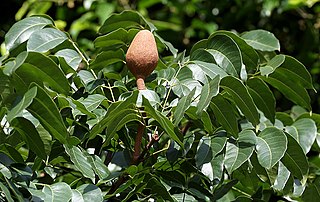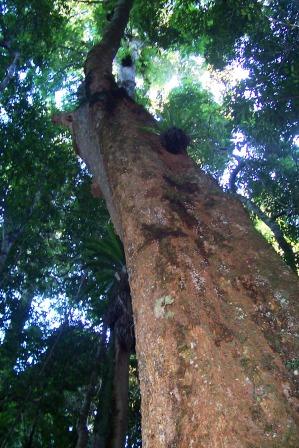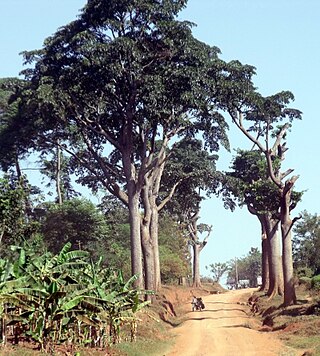
Mahogany is a straight-grained, reddish-brown timber of three tropical hardwood species of the genus Swietenia, indigenous to the Americas and part of the pantropical chinaberry family, Meliaceae. Mahogany is used commercially for a wide variety of goods, due to its coloring and durable nature. It is naturally found within the Americas, but has also been imported to plantations across Asia and Oceania. The mahogany trade may have begun as early as the 16th century and flourished in the 17th and 18th centuries. In certain countries, mahogany is considered an invasive species.

Meliaceae, the mahogany family, is a flowering plant family of mostly trees and shrubs in the order Sapindales.
African mahogany is a marketing name for several African trees whose wood has properties similar to New World mahogany species.
Mahogany refers to dark-colored wood from various types of tree.

Melia azedarach, commonly known as the chinaberry tree, pride of India, bead-tree, Cape lilac, syringa berrytree, Persian lilac, Indian lilac, or white cedar, is a species of deciduous tree in the mahogany family, Meliaceae, that is native to Indomalaya and Australasia.

Shorea is a genus of about 196 species of mainly rainforest trees in the family Dipterocarpaceae. The genus is named after Sir John Shore, the governor-general of the British East India Company, 1793–1798. The timber of trees of the genus is sold under the common names lauan, luan, lawaan, meranti, seraya, balau, bangkirai, and Philippine mahogany.

Khaya is a genus of five tree species in the mahogany family Meliaceae. The timber of Khaya is called African mahogany, and is valued as a substitute to American mahogany.

Swietenia is a genus of trees in the chinaberry family, Meliaceae. It occurs natively in the Neotropics, from southern Florida, the Caribbean, Mexico and Central America south to Bolivia. The genus is named for Dutch-Austrian physician Gerard van Swieten (1700–1772). The wood of Swietenia trees is known as mahogany.

Entandrophragma is a genus of eleven known species of deciduous trees in the family Meliaceae.

Acacia, commonly known as the wattles or acacias, is a large genus of shrubs and trees in the subfamily Mimosoideae of the pea family Fabaceae. Initially, it comprised a group of plant species native to Africa and Australasia. The genus name is Neo-Latin, borrowed from the Greek ἀκακία, a term used by Dioscorides for a preparation extracted from the leaves and fruit pods of Vachellia nilotica, the original type of the genus. In his Pinax (1623), Gaspard Bauhin mentioned the Greek ἀκακία from Dioscorides as the origin of the Latin name.

Afzelia xylocarpa is a tree from Southeast Asia. It grows in Thailand, Vietnam, Cambodia, Laos and Burma in deciduous forests. It can reach 30 metres tall with a trunk up to 2 metres in diameter in a mature specimen.

Toona ciliata is a forest tree in the mahogany family which grows throughout southern Asia from Afghanistan to Papua New Guinea and Australia.

Afzelia africana, the African mahogany, afzelia, lenke, lengue, apa, or doussi, is a tree species in the family Fabaceae.

Swietenia macrophylla, commonly known as mahogany, Honduran mahogany, Honduras mahogany, or big-leaf mahogany is a species of plant in the Meliaceae family. It is one of three species that yields genuine mahogany timber (Swietenia), the others being Swietenia mahagoni and Swietenia humilis. It is native to South America, Mexico and Central America, but naturalized in the Philippines, Singapore, Malaysia and Hawaii, and cultivated in plantations and wind-breaks elsewhere.

Dysoxylum fraserianum, commonly known as rosewood or rose mahogany, is a medium-sized to large tree native to New South Wales and Queensland. It is widely used with the purpose of street design and to provide shade in the eastern suburbs of Sydney. Rosewood ranges from the rainforest around eastern Australia from Bundaberg in Queensland to Wyong in New South Wales. At maturity, it can reach a height of 57 metres (200 ft). It is generally known for its strong scent of rose from its bark.

Bolusanthus speciosus is a species of flowering plants in the family Fabaceae. It belongs to the subfamily Faboideae. It is the only member of the genus Bolusanthus.

Trema orientale is a species of flowering tree in the hemp family, Cannabaceae. It is known by many common names, including charcoal-tree, Indian charcoal-tree, pigeon wood, Oriental trema, and in Hawaii, where it has become naturalized, gunpowder tree, or nalita. It has a near universal distribution in tropical and warm temperate parts of the Old World, with a range extending from South Africa, through the Middle East, the Indian subcontinent and southern China to Southeast Asia and Australia.

Iroko is a large hardwood tree from the west coast of tropical Africa that can live up to 500 years. This is the common name for the genus Milicia, in which there are two recognized species, which are closely related: Milicia excelsa and Milicia regia.

Afzelia quanzensis is a protected tree in South Africa.

Toona sureni is a species of tree in the mahogany family. It is native to South Asia, Indochina, Malesia, China, and Papua New Guinea. It is commonly known as the suren toon, surian, limpaga, iron redwood or the red cedar. It is also known as the Indonesian mahogany or the Vietnamese mahogany. The species is a valuable timber tree.

















